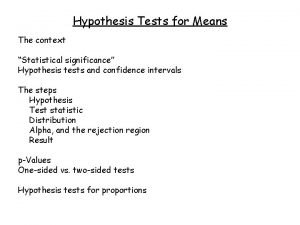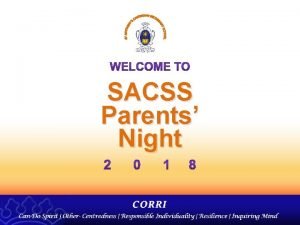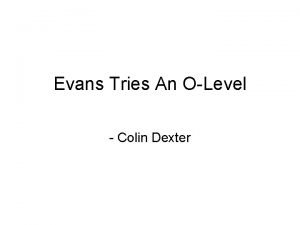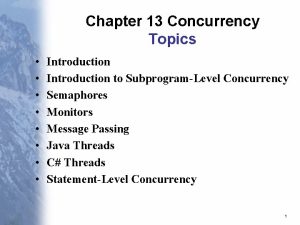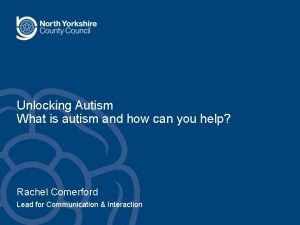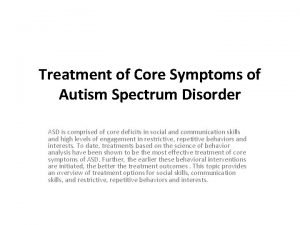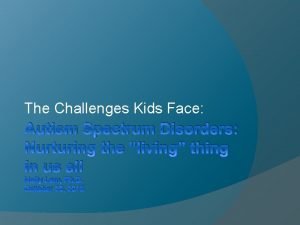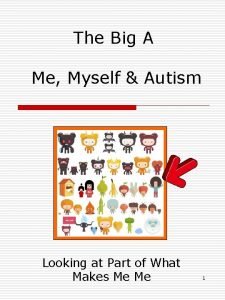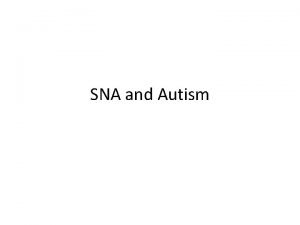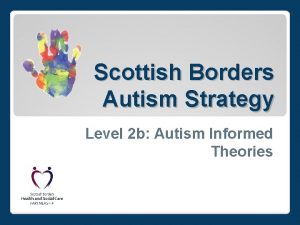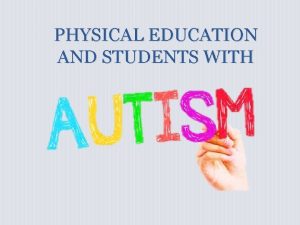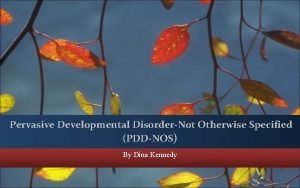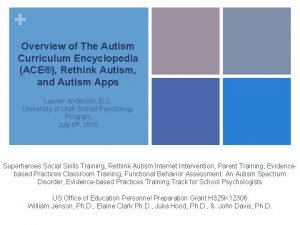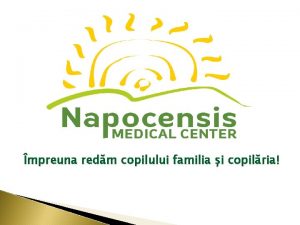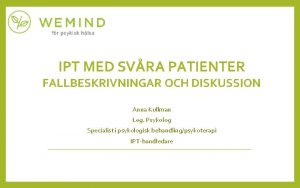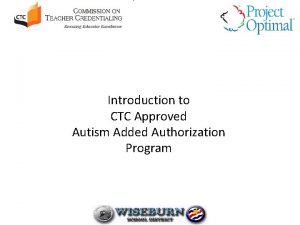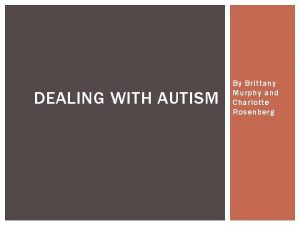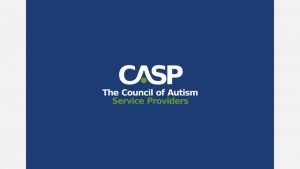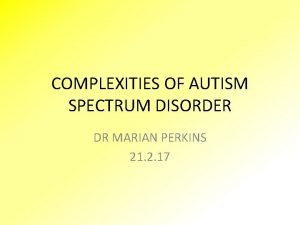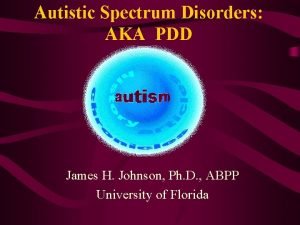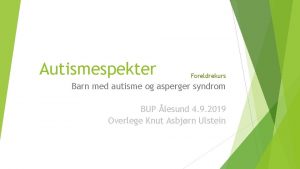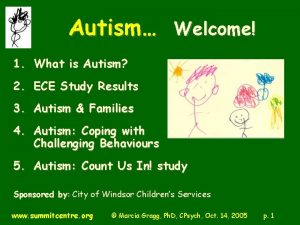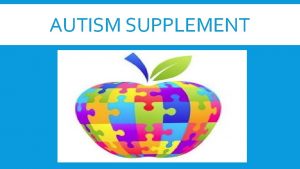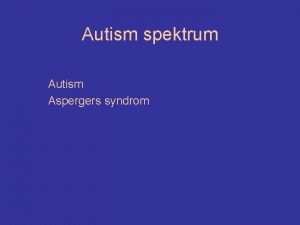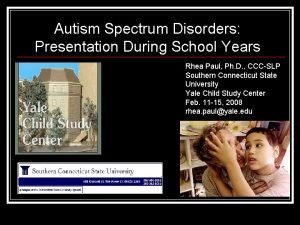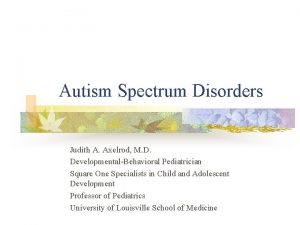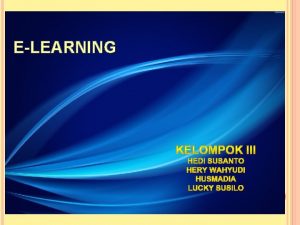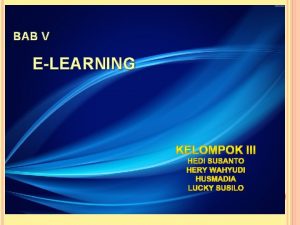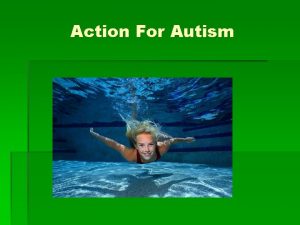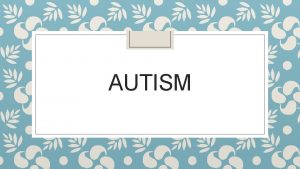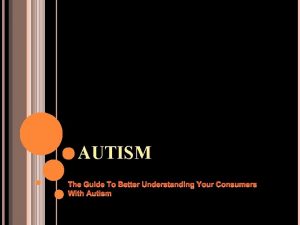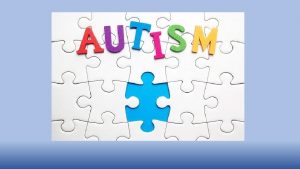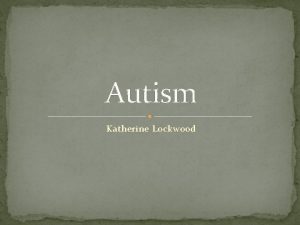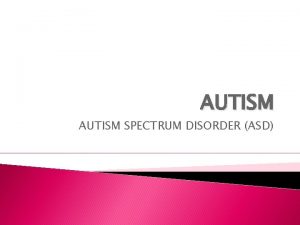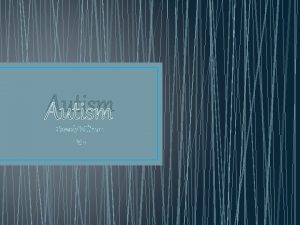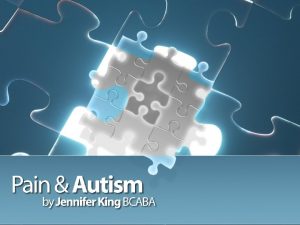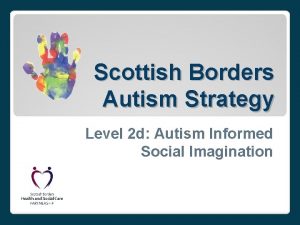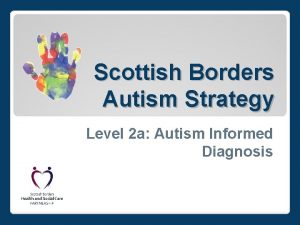Autism Level 1 ELearning Introduction to Autism This








































- Slides: 40

Autism Level 1 E-Learning

Introduction to Autism This ‘Introduction to Autism’ e. Learning module aims to ensure that autism is better recognised and understood, enabling inclusion, independence and well-being for people on the autism spectrum. The module will provide information so that parents, friends, colleagues and professionals can better appreciate people on the autism spectrum and adopt an approach which embraces difference and enables positive change. Practical suggestions and questions to reinforce learning are included throughout the module. This ‘Introduction to Autism’ is the first step to learning. For those who need greater insight and understanding, details of further courses and information sources are given at the end of the module.

Contents • • Overview Characteristics Diagnosis Famously on the Autism Spectrum Myths Course assessment and certificate Further information, reading and courses

Overview ‘Neurodiverse’ Definition of Autism “Autism isn't something a person has, or a "shell" that a person is trapped inside…. . . Autism is a way of being. It is pervasive; it colours every experience, every sensation, perception, thought, emotion, and encounter, every aspect of existence. It is not possible to separate the autism from the person-and if it were possible, the person you'd have left would not be the same person you started with. ” Jim Sinclair-‘Don’t mourn for us’ http: //www. autreat. com/dont_mourn. html

Overview Every person on the autism spectrum is unique but they share certain characteristics. If a person has a significant ‘cluster’ of each of the characteristics listed below the person is likely to be diagnosed as being on the autism spectrum. It is very important to note that each person will have a slightly different ‘cluster’ of characteristics which MAY include some of the following: Sensory -Over/under-responsive senses Thinking-Processing delay/rigid thinking/need for routines Social-Social anxiety/isolation Communication-Dyspraxia/no speech/speech delay/echolalia

Overview ……but also considerable strengths which might include; Strong logic Original humour Skill in retaining facts Intolerance of injustice Original and creative thinking Creative use of language Attention to detail Deep thinking Dedication Loyalty

Overview We have used the phrase ‘on the autism spectrum’ throughout this e learning. However autism is referred to in a variety of ways and many people have strong personal preference. Respect people’s personal preference – it’s their diagnosis!! Commonly used terms include: Autistic – many people now prefer to say ‘I am autistic’ rather than adopting descriptions such as ‘person with autism’ or ‘person suffering from autism’ ASD - Autistic Spectrum Disorder (disliked due to the negative implication of the word disorder). ASC – Autistic Spectrum Condition preferred by some but also disliked due to negative implications. Asperger’s syndrome – diagnosis used until recently for people without childhood speech delay High Functioning Autism - diagnosis used until recently for people with a childhood speech delay

Overview 1. 1% of population may be on the autism spectrum National figure based on census = 695, 000 = 17, 600 people in Hampshire Please note figures are approximate. It continues to be the case that a higher number of males than females are diagnosed as being on the autism spectrum.

Overview Women are often undiagnosed. This is thought to be due to: • the perception of autism as being a ‘male condition’ • different presentation of characteristics • a desire to be more sociable • better ability to copy other peoples’ behaviour in different situations Pictured right – Sophie lives in Hampshire with her partner and works as a business administrator. She was recently diagnosed on the autism spectrum.

Overview The degree of difference experienced by a person is largely influenced by: The level of acceptance and understanding they are shown by those around them The extent to which their everyday environments are adapted to reflect their needs Their access to effective strategies and aids which help minimise harmful situations they may encounter when beyond their ‘comfort zone’ Helpful Approaches • Remember every person is different and has different needs • Accept that people perceive the world in a different way to you, not a wrong way • Take your cue from the person, listen to them and accept and validate their perspective

Overview Helpful Approaches continued… • Encourage the person to accept and be proud of who they are • Offer additional time and support to learn - learning new skills can take longer but can be achieved • Adopt a ‘can do’ positive attitude to ensure the person feels they can achieve their goals • Empower the person to say no to things which will be harmful to them • Expect anxiety if a situation is unfamiliar, changes or is busy and offer additional support • Reduce pressure – don’t rush or overload the person • If a person is trying to ‘escape’ from a particular activity or environment there is always a reason – make sure they have choice and can leave • Be open minded – accept and value difference

Overview The Autism Act 2009 This put a duty on the Government to produce a strategy for adults and statutory guidance for local councils/local health bodies. Fulfilling and Rewarding Lives 2010, was first government strategy for adults on the autism spectrum in England. The revised strategy, ‘Think Autism’ was published in April 2014. The Autism Act Statutory Guidance 2015 This guidance instructs local authorities, NHS bodies and NHS Foundation Trusts what actions should be taken to meet the needs of people living in their area. Pictured right, Dan provides support to local parents as an expert by experience.

Overview – Experts by Experience After each section four local people who are ‘experts by experience’ share their views and personal experiences. Click here to learn about their thoughts on “What is Autism? ” Barnabear Consultant Engineer Married 23 years and father of 2 Arctophile (likes teddy bears) Gill PHD student Harry Potter fanatic! Likes singing and running Luke Administrator Volunteers raising autism awareness Enjoys running, tennis and football Russell Café volunteer Social group leader Enjoys socialising and helping his friends

Characteristics Communication Social Interaction Thinking Sensory Perception

Characteristics - Communication Differences in communication can vary enormously. Some people may never speak but be able to communicate effectively using other methods such as writing, symbols or electronic devices. Some may demonstrate a very advanced level of fluency and creativity in their use of language from a very young age. Others will fall somewhere in between. Often people find it easier to communicate information rather than receive information due to processing delays. Facial expression, body language, tone of voice, and various forms of ‘coded’ communication such as metaphors, banter and sarcasm form a large part of everyday communication. Processing and decoding these subtleties may prove challenging and may lead to over literal interpretation. On the other hand many on the spectrum may themselves use some of these techniques very effectively. Use of eye contact can be painful for some and use valuable energy needed for focussing and processing during an interaction. This can mistakenly give the impression that the person is not listening or paying attention. Difficulties with communication can become much more evident when the person is anxious, or experiencing social or sensory overload.

Communication - Helpful Approaches • Keep verbal communication short, clear, concise, precise and unambiguous • Clearly describe and offer a written order of events. • Back up verbal with written or visual information - objects, pictures gestures , email, text. • Don’t overload with information in one go - ‘bite sized’ chunks • Allow processing time- following any question or request allow response time and don’t fill the thinking time with other words • Don’t assume person is not listening if no eye contact is made • Don’t assume that a person cannot understand what is being said. . check !!

Characteristics – Social Interaction People can find social interaction challenging and exhausting. They can be anxious about meeting other people and often report feeling socially excluded or isolated, although in many cases people do want and benefit from social inclusion. Traits might include: • Not wanting or needing as much social interaction • Finding it difficult to make friends • Wanting some types of relationships but not others • Difficulty reading unwritten social rules and cues for example when to give a compliment • Overwhelmed by large groups, preference for one-toone interactions • Preference for structured social interaction or relationships based on a strongly shared interest. These personal experiences may be viewed by others as out of context for the situation.

Social Interaction Helpful Approaches • Provide a mentor • Make unwritten social rules explicit and detailed • Be open minded to people’s differences and preferences • Accept that the person might appear blunt or rude to you, but that is not their intention only your interpretation • Provide plenty of information about a social event before it takes place. • Empower the person to opt out of social events if it causes unnecessary anxiety • Offer the person a clear role e. g. serving drinks or taking charge of the music, to provide structure and a ready means of escape from interactions they find difficult.

Characteristics - Thinking People on the autism spectrum have brains which are wired differently. This means that information coming in from the outside world is processed in a way that is unique to them. This can result in some uniquely creative perspectives and ideas but also cause some difficulties in everyday situations if the person’s perception is not understood. Many autistic people’s thinking is more sensory than language based. This again can bring a new perspective in a variety of situations Processing Delay This means that it may take longer to take in and process information. Processing delays can range from a few seconds to many minutes. This can be a disadvantage in situations where an instant response is required, but can be advantageous if deep and detailed thought is what is needed ( add practical examples when building e-learning ) Particular Interests Many people have a particular interest which bring intense pleasure. They are more than simply hobbies, they are what the person thinks about most of the time. These particular interests provide predictability and motivation and people often become experts in their chosen fields. Anything can be a particular interest, ranging from football teams and television programs to pieces of string and 50 pence pieces. Some people have more than one particular interest, and some have a range of different interests over their lifetimes. Social interaction may largely be based around such interests.

Thinking - Helpful Approaches • Structure and timetables/schedules can be excellent tools to help people predict what will happen next. • Flowcharts can be helpful to support a person to understand the consequences of their actions, or decide which action to take depending on the situation. • If you think the person may have a processing delay, but you do not know how much of a delay they have, wait at least 10 seconds before repeating the question. • Give plenty of time to spend on their special interest, as it is a source of happiness. • Incorporate a special interests into other activities to motivate.

Characteristics – Sensory Perception People on the autism spectrum may experience sensory differences as part of their ‘cluster’. This can mean that in certain sensory areas a person may be under sensitive compared to others and so seek out experiences that will alert those senses. For example an under sensitivity to taste may explain why someone smothers all food in chili sauce or salt. In other areas the person may be over sensitive and become quickly overwhelmed. For example an oversensitivity to visual stimuli may explain why someone will avoid, or resist using environments that are brightly lit or cluttered. Many people develop ‘stims’ such as rubbing hands together or flapping to self-regulate or produce pleasurable sensations that comfort them or mask other unpleasant sensory stimuli.

Sensory Perception – examples Remember everyone is different! • Sight – Ellie cannot sit in a room with a book case or busy noticeboard, as the amount of visual stimuli is overwhelming. • Sound – for Praia the buzzing of ‘white’ noise can be very uncomfortable and distracting. • Smell – James can’t go in his garden if his neighbour has washing on the line as the smell makes him nauseous. • Touch – Mina chooses to only wear certain clothes as other textures feel rough and uncomfortable. • Taste – Adam is hyper-sensitive to certain tastes and prefer to stick to food he knows well. He does not like to mix foods. • Vestibular (balance) – Wayne loves to go walking but needs help when climbing over gates or styles due to difficulties with balance. • Proprioception (body awareness) – Ricky tried working in a warehouse, but had to give up because tripping or bumping into things made this an unsafe environment for him.

Sensory Perception Helpful approaches • Offer a quiet space to relieve sensory overload • Create a range of activities that are easy to deliver and keep the persons level of sensory arousal ‘topped up’. • If a person says it’s too loud or too bright, believe them and act to reduce their discomfort • Try practical solutions such as ear defenders or light covers • Accommodate personal preferences for food or clothing

Experts by Experience Reasonable Adjustments Our experts by experience give their views on what adjustments help them feel comfortable and able to function to their full potential. Hyperlink to the film will be included

Diagnosis The gateway to diagnosis is : • For an adult, through a GP • For a child is either through a GP or family/self referral to the NHS Like anyone else people on the autism spectrum may have other conditions, which can include learning disability or difficulty, mental health, epilepsy, sleep problems and digestive issues. .

Experts by Experience - Diagnosis Our experts by experience describe both the factors which led up to them seeking a diagnosis, and the process itself. In the final version you will click on the picture to watch the film

Famously on the Autism Spectrum https: //youtu. be/Ny. RTm. C 9 Yn. FY

Autism Myths - causes No! s e in The assertion that autism is caused by vaccines has been completely discredited but the belief is still held by a minority of parents and dubious organisations who may be attempting to sell expensive ‘cures’. There is no cure as autism is not an illness. A child’s pre-existing differences often become more apparent around the age at which they receive the MMR but there is no proven link. r o ? o g P n i t n e r Pa No! Some autistic children may experience attachment issues but these are more likely to relate to the child’s sensory and social differences. Such traits may make it difficult for the child to bond with parents and carers in a typical fashion in early childhood. Engaging with the child in a manner which takes into consideration the child’s sensory and social characteristics often helps. c c Va d an es? r u f ? c o e ? n s k d i e c o l i a o p g L F i r c e s l i l D a No! Whilst it is not a cause many people on the spectrum suffer gastro-intestinal problems some of which may be eased through the introduction of particular diets under proper medical supervision. No! Although it is necessary to give clear explanations concerning rules which must be observed for reasons of safety, illegality etc. , it must always be remembered that people on the spectrum perceive the world differently and often experience high levels of anxiety. Many behaviours appear less bizarre, more logical and understandable when viewed in this light.

Autism Myths - causes No! The assertion that autism is caused by vaccines has been completely discredited but the belief is still held by some parents. There are some organisations who are attempting to sell cures. There is no cure as autism is not an illness. A child’s preexisting differences often become more apparent around the age at which they receive the MMR but there is no proven link. Some children on the autism spectrum may experience attachment issues but these are more likely to relate to the child’s sensory and social differences. Such traits may make it difficult for the child to bond with parents and carers in a typical fashion in early childhood. Engaging with the child in a manner which takes into consideration the child’s sensory and social characteristics often helps. ? s e n i c c a V R O PO ing? t n e r a P No! Whilst it is not a cause many people on the spectrum suffer gastro-intestinal problems some of which may be eased through the introduction of particular diets under proper medical supervision. d o ? o s F e i g r alle it must always be remembered that people on the spectrum perceive the world differently and often experience high levels of anxiety. Many behaviours appear less bizarre, more logical and understandable when viewed in this light. f o k c a L ipline c s i d

More Autism Myths h t l c ? i n t o e i n GPe. OORdi? t nting o C n e r a ea Yes, partly There is evidence to suggest that autistic characteristics are passed on along the male line. It can also occur as a result of a spontaneous mutation in genes passed on to the baby by its mother. However it appears that a number of other circumstantial and environmental factors also play a part. No. Autism is not a form of mental illness. However, there is a high risk that people will go on to develop depression or anxiety disorders if their differences are not understood and accommodated, and if they are constantly made to feel inadequate or deficient. H l a t n Me ue? s s I ? e s a e No. People are born autistic and remain autistic. The search for a ‘cure’ is viewed by many on the spectrum as being both illogical and offensive. It is argued that to cure autism or remove it from the gene pool would be to reduce human diversity and risk losing a group of people who have a unique perception some of whom have changed the world in very significant ways Cu e l b a r s i D P l a c i g ? o e l c o n r f e u o r e k c e N e a f n L ipfli i c s D i d Yes There are differences in both the structure and functioning of the brain. As the brain is responsible for processing sensory, social and communicative input, it follows that those on the spectrum experience the world in a very different way to others. This can be an advantage or disadvantage depending on circumstances. It is not helpful to think of it as wrong.

More Autism Myths No. Autism is not a form of mental illness. However, there is a high risk that people will go on to develop depression or anxiety disorders if their differences are not understood and accommodated, and if they are constantly made to feel inadequate or deficient. Yes, partly There is evidence to suggest that autistic characteristics are genetically passed on. However it appears that a number of other circumstantial and environmental factors also play a part. No. People are born autistic and remain autistic. The search for a ‘cure’ is viewed by many on the spectrum as being both illogical and offensive. It is argued that to cure autism or remove it from the gene pool would be to reduce human diversity and risk losing a group of people who have a unique perception some of whom have changed the world in very significant ways Yes There are differences in both the structure and functioning of the brain. As the brain is responsible for processing sensory, social and communicative input, it follows that those on the spectrum experience the world in a very different way to others. This can be an advantage or disadvantage depending on circumstances. It is not helpful to think of it as wrong. l a t n e M e? u s s i h t l hea R O PO ing? t n e r a P f o k c a L ipline c s i d

Myths – Autism and Mental Health In this short film clip Su shares her experiences of the confusion between mental health and autism. Name: Su • Married for 42 years and mother of 4 • Retired business owner and taxi driver • Currently studying social care • Volunteers as an Autism Ambassador • Enjoys singing and writing poetry Film link (to be inserted)

Autism Hampshire Free Autism Alert Programme Autism Alert Card: used by the card holder to identify that they are on the autism spectrum, provides generic autism information and emergency contact details Autism Alert Car Sticker: displayed inside car to alert emergency services in case of a road incident Autism Alert App: enables individuals to share more personalised information about reasonable adjustments that might benefit them from their mobile phone or tablet Please contact the Autism Hampshire Community Access team for more information. Email: communityaccess@autismhampshire. org. uk One card user told us: “I keep the card in my hand when I know I am going into a situation I will find stressful, so I can show it quickly. ”

Autism assessment 1. Choose the best definition of autism from the options below: o A mental health problem o A disability that causes problems in every aspect of life o A different way of processing the world that influences every aspect of life o A disease that is increasing in the population 2. R O PO ing? t autistic Choose 3 options that could be included in a list e ofncore ar traits: P o Allergies o Processing delay o Attention to detail o Logical and objective thinking 3. Why might girls and women be less likely to receive a diagnosis of autism? o It is a male condition o Women need less support o People are more polite to women and girls o Women are generally better at copying other people’s behaviour f o k c a L ipline c s i d

Autism assessment 4. Why has there been a gradual increase in the number of those diagnosed? o The definition of autism has become broader o Children are not disciplined strictly enough these days o High rate of single parenthood o Additives in processed food and drink 5. R O PO ing? t n eusually: r The first step in seeking a diagnosis of autismais P o Application to the Department of Health and Social Care o Consultation with a GP o Consultation with local disability rights organisation o Contacting the Citizens’ Advice Bureau 6. Fill the gap in the following description; People on the Autism Spectrum perceive the world differently in the following areas: Thinking Social Interaction f o k c a L ipline? c s i d perception Sensory

Autism assessment 7. Choose two strategies that may prove useful and sustainable in accommodating someone who has a sensitivity to bright light. o Frequent exposure to brightly lit environments o Provision of tinted glasses or sunglasses o Avoidance of any environment where bright light is a problem o Wearing a ‘hoody’ or a hat with a peak 8. R O PO ing? t n e r a P Which one of the following options would assist a person on the autism spectrum to operate more independently in a given environment? o Braille o A visual schedule o Constant verbal reminders o A high powered torch f o k c a L ipline c s i d

Autism assessment 9. How could you support the communication needs of someone on the spectrum (choose 2 options) o Shout loudly o Provide clear and concise written or pictorial information o ‘Chunk’ verbal information and allow time to process o Insist that the person gives good eye contact to ensure they are listening R O PO ing? t n e r a P 10. What could you put in place In order to improve social skills (choose 2 options) o Prepare the person adequately before the event o Expose the person to as many social situations as possible so that they pick up such skills o Accept that the person may not wish to attend events where socialising is the sole objective o Reprimand the person for any social gaffes f o k c a L ipline c s i d

Further information Organisations Autism Alliance: https: //www. autism-alliance. org. uk/ National Autistic Society: http: //www. autism. org. uk Autism Hampshire: https: //www. autismhampshire. org. uk/ Local Information Southampton, Portsmouth and Hampshire Autism Information and Advice Service: https: //www. autismhampshire. org. uk/how-we-can-help/outreach/ Local Autism Directory – a one stop shop of autism related information for Hampshire: https: //www. autismhampshire. org. uk/local-autismdirectory/

Further information Research Autism - an organisation that provides objective information on interventions and their evidence: www. researchautism. net Autistica: https: //www. autistica. org. uk/ Autism Research Network , Portsmouth University: http: //www. port. ac. uk/department-of-psychology/communitycollaboration/autism-research-network/

Further information You Tube Links Positive talks: • How autism freed me to be myself - Rosie King (https: //www. youtube. com/watch? v=j. Q 95 xl. Ze. Ho 8&t=8 s) – 6 minutes • What it feels like to be autistic – Temple Grandin (https: //www. youtube. com/watch? v=1 q. PFAT 4 p 8 Lc&t=16 s) – 2 minutes • Living with Autism – Thomas Williams (https: //www. youtube. com/watch? v=t. Ir 1 q_t 907 k) – 5 minutes Sensory: • Can you make it to the end (https: //www. youtube. com/watch? v=Lr 4_d. Oorqu. Q&t=12 s) – 1 min 24 secs • Make it stop (https: //www. youtube. com/watch? v=x. HHw. ZJX 67 -M) – 1 min 20 secs • STEVE COPE The National Autistic Society Sensory Overload (https: //www. youtube. com/watch? v=IXXIZKIedjg&t=4 s) – 1 min 08 secs • National Autistic Society train film (https: //www. youtube. com/watch? v=Q 6 G-Op. Ggo 3 c) – 2 min 06 secs • Carly's Café - Experience Autism Through Carly's Eyes (https: //www. youtube. com/watch? v=Km. DGvquzn 2 k) – 2 mins 18 secs
 Autism
Autism Molecular level vs cellular level
Molecular level vs cellular level Isis protocol
Isis protocol Dr shaffi
Dr shaffi Isis level 1 vs level 2
Isis level 1 vs level 2 Confidence level and significance level
Confidence level and significance level Confidence level and significance level
Confidence level and significance level Dfd level 0 and level 1
Dfd level 0 and level 1 Piramida level keamanan informasi memiliki berapa level
Piramida level keamanan informasi memiliki berapa level Levels of questions
Levels of questions Instruction level parallelism vs thread level parallelism
Instruction level parallelism vs thread level parallelism Low-level thinking in high-level shading languages
Low-level thinking in high-level shading languages Grade 4 pfp
Grade 4 pfp Introduction of evans tries an o level
Introduction of evans tries an o level Explain subprogram level concurrency with an example.
Explain subprogram level concurrency with an example. The autism iceberg
The autism iceberg Core symptoms of autism
Core symptoms of autism Many faces of autism
Many faces of autism Autism range severity
Autism range severity The big a autism
The big a autism Special needs
Special needs Central coherence theory autism
Central coherence theory autism Puberty and autism spectrum disorders
Puberty and autism spectrum disorders Physical education adaptations for autism
Physical education adaptations for autism Pdd nos
Pdd nos Ace necc
Ace necc Tratament pentru autism infantil
Tratament pentru autism infantil Fallbeskrivning autism
Fallbeskrivning autism Autism spectrum disorders added authorization
Autism spectrum disorders added authorization Does sheldon cooper have autism
Does sheldon cooper have autism Macey hensley autism
Macey hensley autism Autism legal resource center
Autism legal resource center Social pragmatic communication disorder
Social pragmatic communication disorder Hackney autism service
Hackney autism service Aspergers vs autism
Aspergers vs autism Autism nivå 3 barn
Autism nivå 3 barn Ece 4 autism
Ece 4 autism Texas autism supplement
Texas autism supplement Enkopres autism
Enkopres autism Autism prognosis
Autism prognosis Splinter skills
Splinter skills






